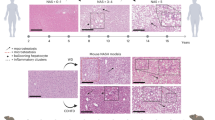Abstract
Alcoholic liver disease (ALD) is one of the most common causes of chronic liver disease in Western countries. The spectrum of ALD ranges from simple steatosis to steatohepatitis to cirrhosis and hepatocellular carcinoma. Over the past 50 years, several animal models of ALD have been developed. Although none of them faithfully recapitulates the human disease, they have proven to be invaluable tools to study the pathogenesis of ALD, to identify potential therapeutic targets and to test new drugs. Here, we describe the mouse model of chronic and binge ethanol feeding, also known as the NIAAA model or Gao binge model. This model combines chronic feeding of Lieber–DeCarli ethanol liquid diet with acute administration of high-dose ethanol by oral gavage to mimic the drinking patterns of many alcoholic patients who engage in episodes of binge drinking on top of chronic daily drinking. Short-term (10-day) chronic plus single binge ethanol feeding causes a substantial increase in serum transaminase levels, moderate steatosis and mild inflammation characterized by lobular neutrophil infiltration. Long-term (8-week) chronic plus single or multiple (twice a week) binge ethanol feeding induce more severe steatohepatitis and mild fibrosis. This clinically relevant, easy-to-perform model of ALD is currently used by many research laboratories to reproduce early stages of human alcoholic steatohepatitis.
Access this chapter
Tax calculation will be finalised at checkout
Purchases are for personal use only
Similar content being viewed by others
References
Mathurin P, Bataller R (2015) Trends in the management and burden of alcoholic liver disease. J Hepatol 62(1 Suppl):S38–S46. https://doi.org/10.1016/j.jhep.2015.03.006
Gao B, Bataller R (2011) Alcoholic liver disease: pathogenesis and new therapeutic targets. Gastroenterology 141(5):1572–1585. https://doi.org/10.1053/j.gastro.2011.09.002
Mandrekar P, Bataller R, Tsukamoto H, Gao B (2016) Alcoholic hepatitis: translational approaches to develop targeted therapies. Hepatology 64(4):1343–1355. https://doi.org/10.1002/hep.28530
Bertola A (2018) Rodent models of fatty liver diseases. Liver Res 2(1):1–11. https://doi.org/10.1016/j.livres.2018.03.001
Mathews S, Xu M, Wang H, Bertola A, Gao B (2014) Animals models of gastrointestinal and liver diseases. Animal models of alcohol-induced liver disease: pathophysiology, translational relevance, and challenges. Am J Physiol Gastrointest Liver Physiol 306(10):G819–G823. https://doi.org/10.1152/ajpgi.00041.2014
Tsukamoto H, Machida K, Dynnyk A, Mkrtchyan H (2009) “Second hit” models of alcoholic liver disease. Semin Liver Dis 29(2):178–187. https://doi.org/10.1055/s-0029-1214373
Lazaro R, Wu R, Lee S, Zhu NL, Chen CL, French SW, Xu J, Machida K, Tsukamoto H (2014) Osteopontin deficiency does not prevent but promotes alcoholic neutrophilic hepatitis in mice. Hepatology 61:129. https://doi.org/10.1002/hep.27383
Ueno A, Lazaro R, Wang PY, Higashiyama R, Machida K, Tsukamoto H (2012) Mouse intragastric infusion (iG) model. Nat Protoc 7(4):771–781. https://doi.org/10.1038/nprot.2012.014
Bertola A, Park O, Gao B (2013) Chronic plus binge ethanol feeding synergistically induces neutrophil infiltration and liver injury in mice: a critical role for E-selectin. Hepatology 58(5):1814–1823. https://doi.org/10.1002/hep.26419
Cai Y, Xu MJ, Koritzinsky EH, Zhou Z, Wang W, Cao H, Yuen PS, Ross RA, Star RA, Liangpunsakul S, Gao B (2017) Mitochondrial DNA-enriched microparticles promote acute-on-chronic alcoholic neutrophilia and hepatotoxicity. JCI Insight 2(14):e92634. https://doi.org/10.1172/jci.insight.92634
Ki SH, Park O, Zheng M, Morales-Ibanez O, Kolls JK, Bataller R, Gao B (2010) Interleukin-22 treatment ameliorates alcoholic liver injury in a murine model of chronic-binge ethanol feeding: role of signal transducer and activator of transcription 3. Hepatology 52(4):1291–1300. https://doi.org/10.1002/hep.23837
Li M, He Y, Zhou Z, Ramirez T, Gao Y, Gao Y, Ross RA, Cao H, Cai Y, Xu M, Feng D, Zhang P, Liangpunsakul S, Gao B (2017) MicroRNA-223 ameliorates alcoholic liver injury by inhibiting the IL-6-p47(phox)-oxidative stress pathway in neutrophils. Gut 66(4):705–715. https://doi.org/10.1136/gutjnl-2016-311861
Mathews S, Feng D, Maricic I, Ju C, Kumar V, Gao B (2016) Invariant natural killer T cells contribute to chronic-plus-binge ethanol-mediated liver injury by promoting hepatic neutrophil infiltration. Cell Mol Immunol 13(2):206–216. https://doi.org/10.1038/cmi.2015.06
Xu MJ, Cai Y, Wang H, Altamirano J, Chang B, Bertola A, Odena G, Lu J, Tanaka N, Matsusue K, Matsubara T, Mukhopadhyay P, Kimura S, Pacher P, Gonzalez FJ, Bataller R, Gao B (2015) Fat-specific protein 27/CIDEC promotes development of alcoholic steatohepatitis in mice and humans. Gastroenterology 149(4):1030–1041.e1036. https://doi.org/10.1053/j.gastro.2015.06.009
Gao B, Xu MJ, Bertola A, Wang H, Zhou Z, Liangpunsakul S (2017) Animal models of alcoholic liver disease: pathogenesis and clinical relevance. Gene Expr 17(3):173–186. https://doi.org/10.3727/105221617X695519
Fulham MA, Mandrekar P (2016) Sexual dimorphism in alcohol induced adipose inflammation relates to liver injury. PLoS One 11(10):e0164225. https://doi.org/10.1371/journal.pone.0164225
Ramirez T, Li YM, Yin S, Xu MJ, Feng D, Zhou Z, Zang M, Mukhopadhyay P, Varga ZV, Pacher P, Gao B, Wang H (2017) Aging aggravates alcoholic liver injury and fibrosis in mice by downregulating sirtuin 1 expression. J Hepatol 66(3):601–609. https://doi.org/10.1016/j.jhep.2016.11.004
Kirpich IA, Miller ME, Cave MC, Joshi-Barve S, McClain CJ (2016) Alcoholic liver disease: update on the role of dietary fat. Biomol Ther 6(1):1. https://doi.org/10.3390/biom6010001
Bertola A, Mathews S, Ki SH, Wang H, Gao B (2013) Mouse model of chronic and binge ethanol feeding (the NIAAA model). Nat Protoc 8(3):627–637. https://doi.org/10.1038/nprot.2013.032
Author information
Authors and Affiliations
Corresponding author
Editor information
Editors and Affiliations
Rights and permissions
Copyright information
© 2020 Springer Science+Business Media, LLC, part of Springer Nature
About this protocol
Cite this protocol
Bertola, A. (2020). Mouse Model of Alcoholic Steatohepatitis. In: Aouadi, M., Azzimato, V. (eds) Kupffer Cells. Methods in Molecular Biology, vol 2164. Humana, New York, NY. https://doi.org/10.1007/978-1-0716-0704-6_15
Download citation
DOI: https://doi.org/10.1007/978-1-0716-0704-6_15
Published:
Publisher Name: Humana, New York, NY
Print ISBN: 978-1-0716-0703-9
Online ISBN: 978-1-0716-0704-6
eBook Packages: Springer Protocols




